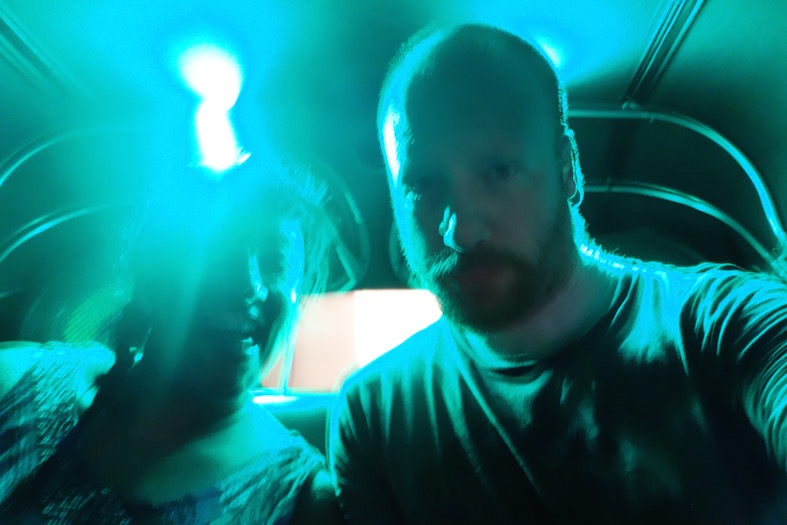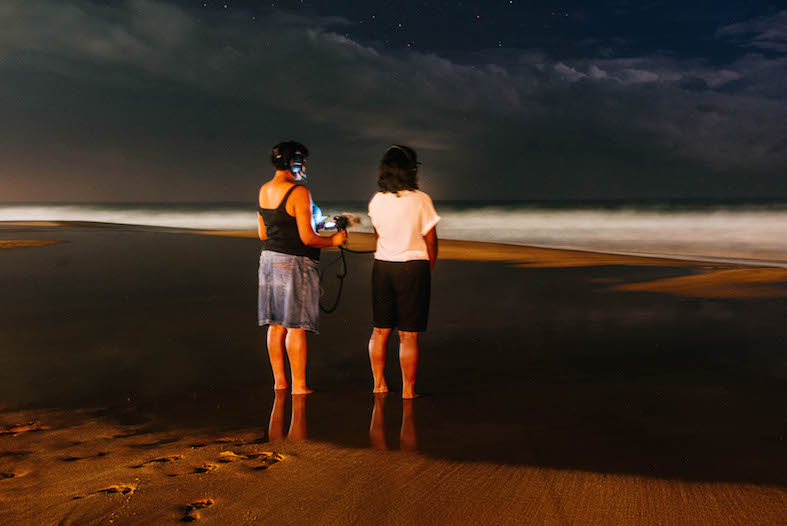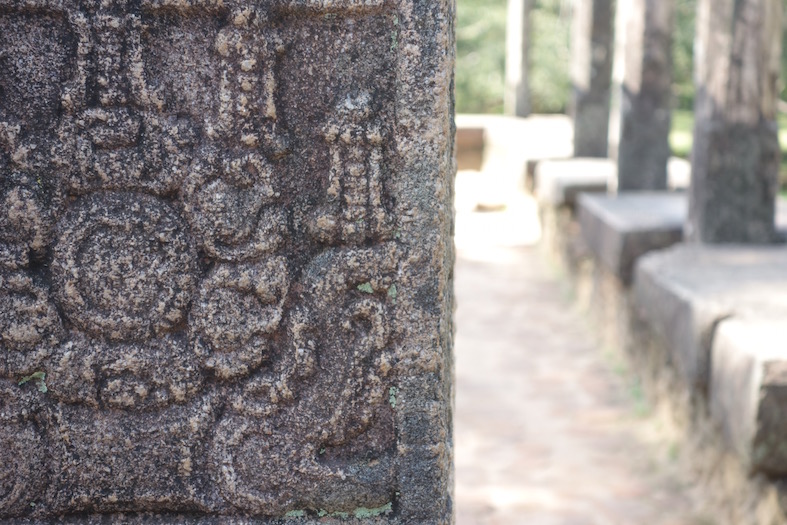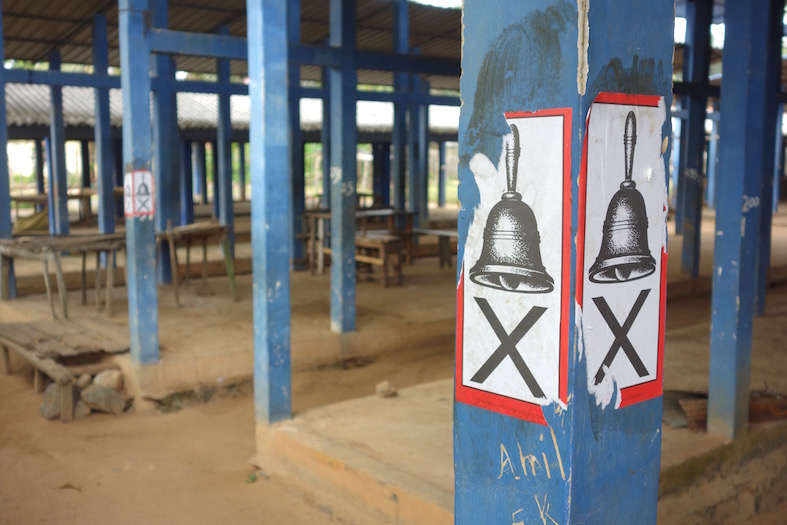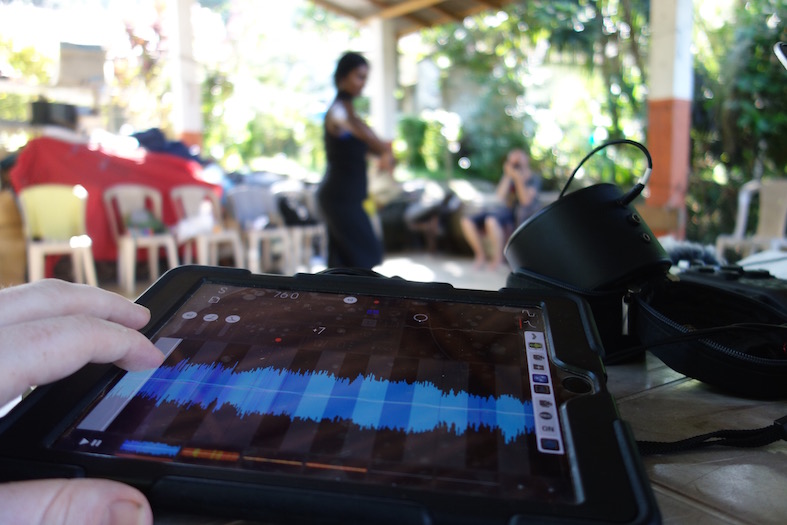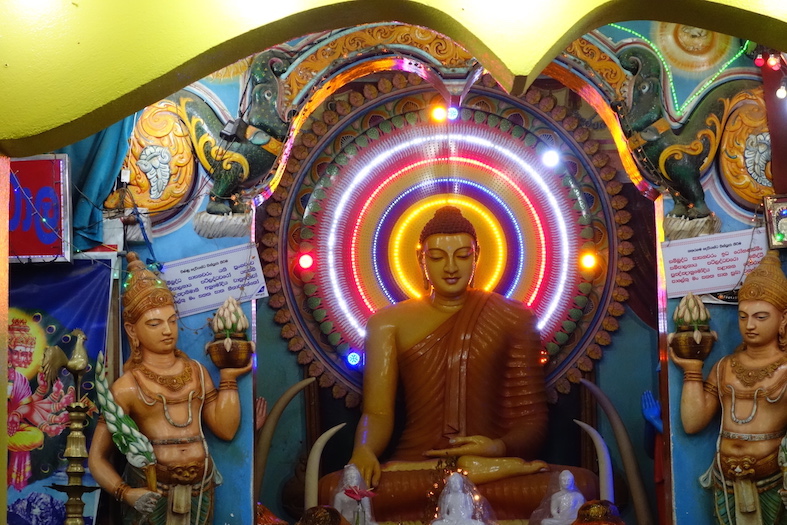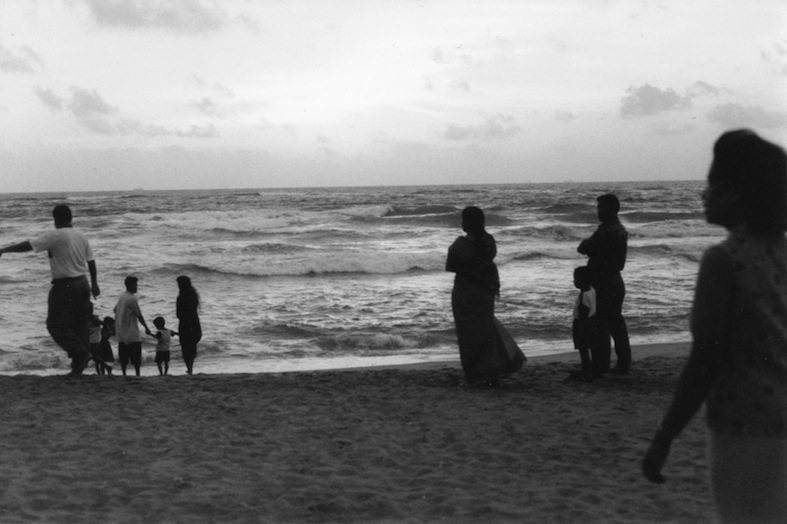On tourism, and a tourist’s job.
I’ve been working in Sri Lanka for the last 6 weeks, although my visa is technically correct when it says I’ve been here on holiday. I haven’t been paid for what I’m doing in the country.
Tanuja and I have made a short album of music and played it out of a tuk tuk’s soundsystem –
– developed a piece for headphones installed at the edge of the ocean –
– and made or mixed soundtracks for works by all our colleagues on the Sura Medura residency. But on the most basic level we and our fellow artists are all here as tourists.
This means there’s a kind of daily tension to our identities, and I’ve been thinking about it throughout our time here, especially as Hikkaduwa is a proper tourist hotspot.
Tourists are economic migrants. Sure, the power relationship is different to other kinds of economic migration; the commitment on the part of the holiday-maker is shorter and obviously less arduous – but all the same, the parallels are fascinating to me.
Like working migrants, tourists variously choose or find themselves channelled into patterns of behaviour when in another country. Some attempt to learn parts of the local language(s), some don’t. Some are there simply for the financial transaction, others look for an investment that feels somehow progressive or hopeful or true.
Some form temporary communities or enclaves, others believe the better experience comes from hybridisation, a conversation between people from different places. Others still think that the only honest or viable path is to assimilate fully. And tourists get into trouble too, of course, for legal or cultural transgressions they’d failed to spot, or they find themselves ill-equipped to deal with their physical environments.
The exploitation of tourists is obviously of a different strain to the abuse suffered by working migrants – the repercussions are vastly different and there’s little-to-no comparison there, no doubt at all where the privilege lies. At the same time I think it’s fair to say tourists are both sought after and vilified by their host cultures.
During the residency I’ve been suspicious of any talk that paints Hikkaduwa as an unreal Sri Lanka, a pricey ivory tower in contrast to cities like Colombo – or that discusses somewhere like Galle, an old colonial town, as ‘true’ in its urban sprawl and ‘false’ in the chintzy streets within the old fort with its air-conditioned shops and iced coffees.
Tourist Sri Lanka is one of the many real Sri Lankas. The dreadlocked trustafarians with their constant fucking djembes are definitely real. The lives of the hotel and bar workers are real, as are the drug deals that take place in the WCs of the more popular bars and the gangster boys who hang out on motorcycles outside, late into the night.
The fear of the beaches on the part of many local women, discovered by our fellow artists Periplum during their research, is palpably real. There’s the sense that the beaches are physically treacherous, morally loose, a genuine no-go zone for a good half of the population – making a laughing stock of the favoured Fox News trope that whole swathes of European cities are off-limits to scared white people.
The astonishing ebb and flow of activity around high and low season, the rush followed by deadly boring months-long lull, is as real in Hikkaduwa as it is in Blackpool or Paraty or Slanchev Bryag. And the diverse ways that Hikkaduwans accept their foreign visitors – joyful, mundane, sad, hopeful – are as real as the relationships between the fishermen and the sea.
So: a few small stories from the edge of being, and living with, tourists.
After sunset at one of the beachside bars, Tanuja and I were joined at the table by a 40-something Lankan beach boy who was so hammered on booze and skunk he would often pause for a whole 30 seconds between sentences without realising it. But the genial rambling speeches he gave us in fractured and heavily colloquial English were a good old-fashioned song familiar all over the world: the glass in his hand didn’t control him, fuck it, he didn’t need it; he’d been drinking since he was 9 years old; he knew everyone here, everyone knew him; he wasn’t ‘from’ anywhere; he was drummer, he could teach you how to drum, he’d sprained his hand; he owned a hotel of 40 rooms and let everyone stay there for free, foreigners, whoever; he was annoyed when his freeloading guests didn’t help to pay the water or electricity bills, especially the fucking Russians, who want everything for nothing; we seemed like we could be friends, he didn’t normally talk to foreigners; he didn’t understand why people bad-mouthed us artists but still turned up to look at the residents’ work; he thought people were full of shit.
We invited him to the Sura Medura event then he drifted away like one of the itinerant souls in a Graham Greene or JG Ballard novel, an astronaut living on the edge of the sand. Find me anytime, ask for me by name, he said – everyone knows me here. The next time I saw him with a cheery hello, he didn’t recognise me at all. So I asked our host about him, citing his name as suggested… and they had absolutely no idea who he was.
Elsewhere: in the Community Tsunami Museum at Peraliya I was in the room where they display the most distressing images from the Boxing Day disaster. The same room also contains the donation box. The museum’s co-founder Priyanti was asking a tall Scandinavian gentleman whether he’d like to make a donation.
As he gazed at the images of swollen, drowned bodies stretched across railway tracks, thrown into the backs of vans without ceremony or dignity by grim soldiers, orphans crying, a western man in floods of uncontrollable tears carrying a screaming Sri Lankan child through a channel of corpses, the gentleman said: “I haven’t got anything small enough.”
I think Priyanti did well to respond with just the right kind of tiny smile and to ask: “You don’t have anything small enough?” – not hectoring, not aggressive, just repeating what he said. “I told you I don’t have anything,” he replied, “Don’t make fun of me,” and immediately left the museum.
Elsewhere: the collected Sura Medura artists were lost in Colombo, having wandered into the mid-day sun in search of a National Museum a ‘short walk’ around the corner which turned out to be 25 minutes away and also on the point of shutting. But just before giving in and hailing tuk-tuks, we found ourselves in the diplomatic district, outside The Commission To Investigate Allegations Of Bribery or Corruption. We knew it was the Commission To Investigate Allegations Of Bribery or Corruption because it said so on a surprisingly large sign by the gate, and we were particularly excited by a billboard to its left, an advert for a radio station that exhorted, in huge capitals: JUST SAY YES.
So out came our cameras to fully capture the irony (Brian Hartley in particular being an avid documenter of unexpected details in the environment.) By the gates to the commission a two-man film crew was hanging out, buzzing at any car that approached the entrance, waiting for a catch. Once they saw that this weird cavalcade of behatted tourists opposite was filming, they began to film us in return – perhaps on the offchance we were something to do with someone within, perhaps capturing us as a visual comment on the Commission’s very presence, perhaps saying “look at these prurient westerners with their openly dishonest Presidents and their flailing economies, what have they to gawp and giggle at?” But whichever way, after a weird but brief standoff, all cameras were lowered and everyone went back about their business.
As we zipped across town to the almost-shut museum I wondered whether we’d been respectful – whether taking those pictures was the way we’d behave in other countries, within any culture. I believe I’d think twice about pointing a camera at an obscure government building in Moscow or Tehran or Washington DC, but that’s a practical attitude rather than purely a matter of respect.
Maybe I count enough Sri Lankans in my family to hope it’s a joke shared, that taking pictures of ironic arrangements of signs is something I’d do pretty much anywhere I felt safe – that in some ways it’s a greater expression of respect and love for a place to feel reasonably confident I won’t get detained or arrested for it.
Tourism is part of the real. You have to be a realistic tourist.
The first time I came to this country in 2001, the airport had been attacked by the Tamil Tigers a matter of weeks before, and 9/11 had given Sri Lanka’s travel industry a double-blow. Visiting the principle heritage sites like the temples at Anuradhapura or Kandy, I felt like one of only a handful of westerners in the country. People who worked with tourists were obviously having a desperate time, and there were even moments where crowds of people stood to one side with shouts of ‘white man coming!’ as I approached. It was weird as hell.
One image of that desperation will forever stick in my mind. Our hosts were cramming in as many locations as the 10-day itinerary would allow and a lot of our trip was spent rattling from town to town in a car – and this was before the expressways were built, so we mostly drove at breakneck speeds along winding narrow roads.
Heading from the higher lands outside Kandy down to the south early one morning, we descended a lush mountainside, our driver making time, pedal to the metal. Just before we began the descent a kid who couldn’t have been more than 8 or 9 years old leapt towards the car with a crop of freshly-picked flowers in his hand, desperate to get our attention and make a sale, yelling “AiYY!” at the top of his lungs. The driver zoomed past him and took a zig-zag in the road that looped downhill and back on ourselves, in a snaking pattern which would repeat all the way down.
As we approached the mid-point of this lower stretch, I saw that the flower kid was hurtling with almost suicidal recklessness in a straight line downhill, through the dense foliage, rushing to meet us again, chasing what he could see: a posh car with blacked out windows, a tourist car. And he burst out onto the road milliseconds before we passed the mid-point again, flowers outstretched, repeating his yell of “AiYY!”
The kid did this on every loop of road down to the bottom of the mountain, eight fucking times. In his barefoot sprints through the jungle he held the flowers high above his head so as not to wreck them. Each time he leaped out onto the road’s edge a split second ahead of us, I was convinced the scowl on his face was deepening, the “AiYY!” more incensed, more offended, and I was petrified we’d hit him – because our driver was a government employee with a schedule, driving with complete authority, and we were stopping for nothing.
We didn’t hit the kid. I wish we’d been able to stop. I don’t know if I’d have bought the flowers – I would at the very least have told him I didn’t want to buy the flowers, and asked him not to chase after us again. Maybe at that point he would have slapped me. But at least the situation would have been clear. I was very grateful to my hosts on that whistle-stop tour of the island, we saw some amazing sights… but the kid on the mountainside cemented a resolve to never want to travel that way again, skimming the surface, behind darkened glass, not stopping, unable to even say ‘no, thank you.’
So that’s one of the reasons why on this residency Sleepdogs barely left Hikkaduwa, planting our feet in the sand, watching the sunset from roughly the same place every single night for 6 weeks. Chance had landed us in tourist central, so we got to know tourist central as well we could. And I decided to accept my part as a tourist – something I’ve previously fought against pretty hard, despite blatantly being the biggest gringo you ever did see – and soak up the contradictions. On our last day together in Hikkaduwa the Sura Medura artists gathered in the town’s most famously upmarket hipster joint for a – relatively – pricey goodbye brunch, and we laughed about how it was as if we’d come all the way to Sri Lanka just to go to Shoreditch.
I think these contradictions have found their way into Sleepdogs’ work here; if only in something like the song title Stray Dog Dance / Selfie Stick from the LNK_A album we’ve made. But it’s also in the fact that nothing we’ve worked on out in Sri Lanka has been kept ‘pure’, bereft of the presence of travellers, rooted only in identifiably Lankan influences. The samples on our record feature fragments of hip hop as well as Kandyan dance – because hip hop and reggae are your tuk-tuk driver’s sonic weapons of choice.
Including all of this has as much to do with our belief in art as living, breathing, not pickled, as it does with this particular environment. On our first week out here I spent the mornings reading some essays by Alan Lomax, the pioneering folklorist and song collector, and was struck by one aspect of his innovation: how he and his father would search out not what were called the ‘survivors’, the unique or lost songs, the as-yet unheard or unrecorded, like most collectors of the time did – but would instead often keep documenting the same pieces of music by different singers in different places, celebrating and charting the ongoing life of the song rather than anything that might be called a purity of expression.
So my fellow tourists are as much part of the fabric of travelling, as much part of the sights I’m seeing or the things I’m hearing, as the ancient monuments or the striated skies. The sunsets in Hikkaduwa have been pretty much uniformly gorgeous, but equally astonishing is the human behaviour at the edge of the ocean every single evening, drones whirring overhead to get the full effect of people splashing romantically in the surf, Chinese women throwing joyful giggling poses against the sea breeze, everyone zipping back and forth between lens and screen, checking, reframing, checking, filtering, uploading.
I get mental images of future data archaeologists mining the broken hard-drives of our civilisation, uncovering some thousand billion crepuscular instagram horizons, and concluding we were as obsessed with the setting sun as the Aztecs.
In our last week on the island, spending time with Tanuja’s family, we joined her dad CJ on a trip to Somawathiya Chaitya, a Buddhist temple in the jungle just at the border of the north-central and eastern provinces. The day had been spent in Polonnaruwa, the site of an old capital, a ruined city in gladed forest, a proper tourist mecca. Somawathiya was different: difficult to get to, not so much a guidebook fixture, but truly peaceful, with elephants grazing at the temple boundaries and a reputation for unexplained miraculous incidents – documented in a little gallery behind the bo tree shrine that seemed to mostly consist of pictures of dramatically encircled lens flare.
T and I took our cameras and our recording equipment that night, sure, but in the end only captured a few quick snaps of the elephants for our niece and nephews… no sound recordings at all. Instead we hung back and watched the evening ceremonies unfold, breathed in the jungle air, got stung by a few mosquitoes, and felt the light dip to darkness around us. No document to speak of, just the memory. That felt right.
It reminded me of our first trip in 2001, during a bad drought, when a scheduled power outage hit just at the point T and I were left alone with one of Sri Lanka’s most revered monuments, the Ruwanwelisaya Stupa in Anuradhapura. By chance it was just us and the immense white shape in the dark of night, with one emergency light, a single flickering fluorescent strip, intermittently crackling to life, making the whole building look like a dream, a faulty loop of film, a ghost moving in and out of our present dimension. We’d left the video camera in the car. “Shall we go and get it?” I asked quietly, and pretty much together we both decided, no, no, best not.



